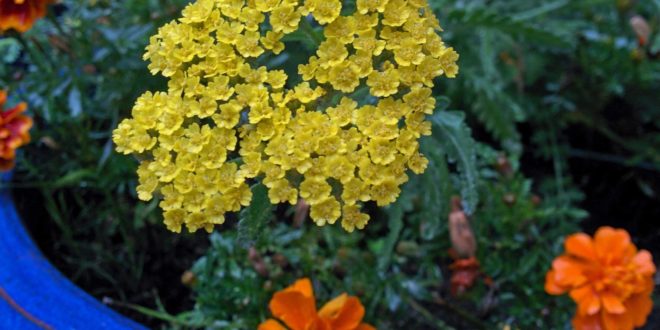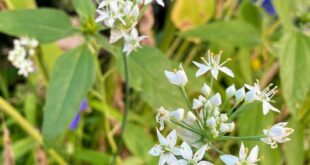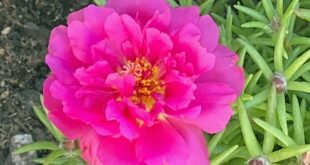Yarrow (Achillea spp.) adds bright spots of color to the garden in summer and fall. My mother has always had the tall yellow yarrow in her Almaden Valley garden. It complemented the blue and white flowers of Mexican Sage. The flower heads are large, flat-topped umbels packed with tiny flowers. This hardy, drought-resistant perennial still thrives with poor soil and neglect. The size ranges from little 6-inch species such as woolly yarrow (A. tomentosa) that is used in rock gardens or as a ground cover, to the towering cultivars of the fern-leaved yarrow (A. filipendulina) that can reach heights of 5 feet. Yarrow needs full sun and well-drained soil. The hardiness varies with the species, but most are hardy in U.S. Department of Agriculture plant hardiness zones 3 through 8.
Water new transplants and divisions to keep the soil lightly moist through their first spring. Water slowly to make sure the water sinks in to saturate the root zone, and then wait until the surface of the soil is dry before watering again. Established plants don’t need watering.
Support tall varieties with stakes or grow-through supports such as hoops or cages. Pound the stake into the ground a few inches from the main stem and tie the stem loosely to the stake with twine. Place hoops or cages over the plants and push the legs into the soil. Install supports before the plants begin to bloom, which may be as early as late spring in mild, Mediterranean climates.
Clip off the faded flower heads to a point just above the foliage with hand pruners. Prompt removal of the flower heads keep the plant blooming longer and prevents it from self-seeding.
Divide clumps of yarrow every other year in spring or fall. The clumps can spread as much as 1 foot every year, so regular division is essential to keep them in check and prevent overcrowding. Dig around the clump to loosen the soil and then slide a shovel under the roots and lift the entire clump. Replant only one-fourth to one-third of the clump in the original location.
Fertilize yarrow every other year in late fall or winter. Use a shovelful of compost or a sprinkling of organic fertilizer.
Things You Will Need
- Stakes or grow-through support
- Twine (optional)
- Hand pruners
- Shovel
- Compost or organic fertilizer
Yarrow makes an excellent cut flower that lasts a long time in the vase. Cut the stems when you can see the pollen on the flowers. To dry yarrow, cut the stems when the flowers just begin to open and hang them upside down in bundles.








